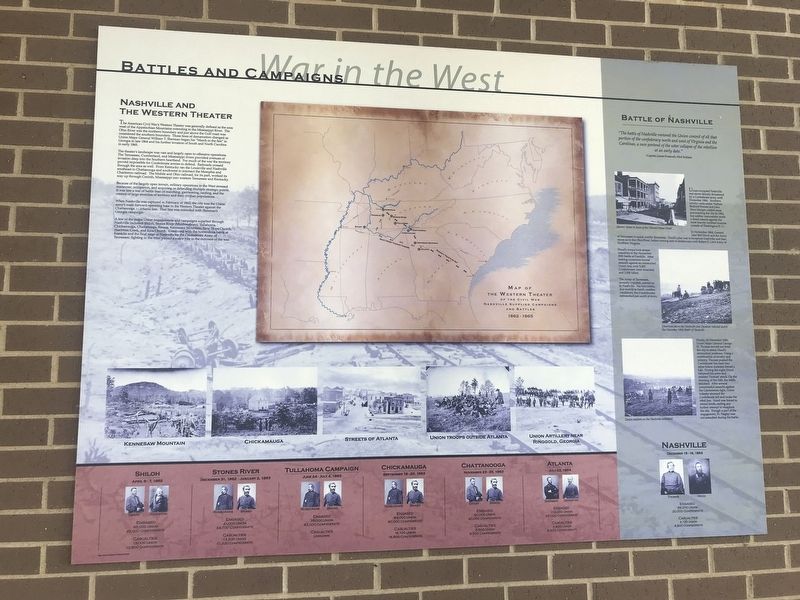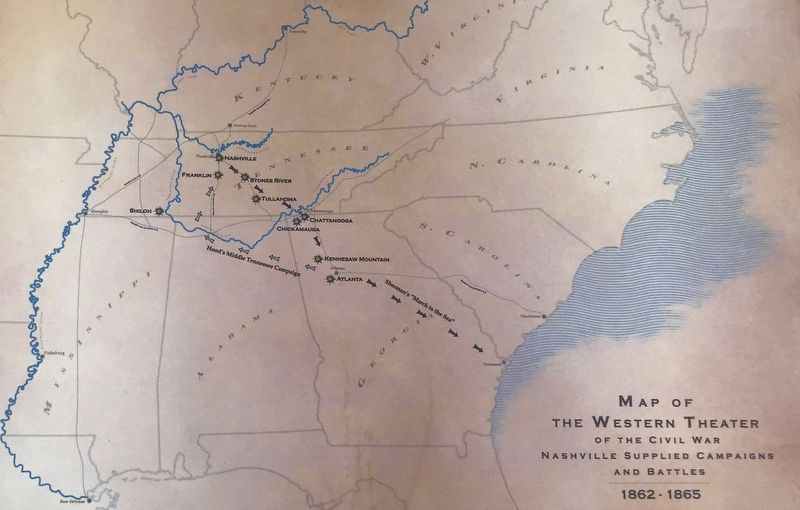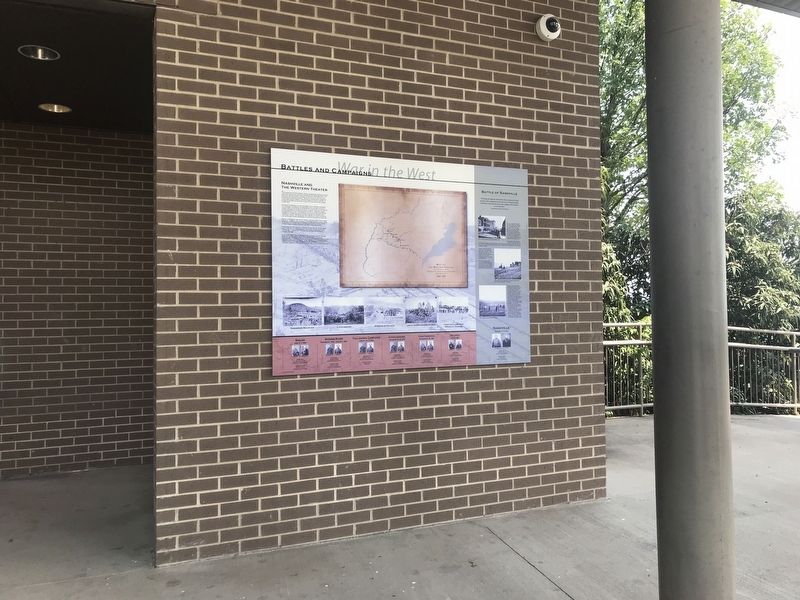South Nashville in Davidson County, Tennessee — The American South (East South Central)
War in the West: Battles and Campaigns
Inscription.
Nashville and the Western Theater
The American Civil War's Western Theater was generally defined as the area west of the Appalachian Mountains extending to the Mississippi River. The Ohio River was the northern boundary and just above the Gulf coast was considered the southern boundary. Those lines of demarcation changed as Union Major General William T. Sherman began his "March to the Sea" in Georgia in late 1864 and his further invasion of South and North Carolina in early 1865.
The theater's landscape was vast and largely open to offensive operations. The Tennessee, Cumberland, and Mississippi rivers provided avenues of invasion deep into the Southern heartland. For much of the war the territory proved impossible for Confederate armies to defend. Railroads crossed through the area as well. From Kentucky ran the Louisville and Nashville southeast to Chattanooga and southwest to intersect the Memphis and Charleston railroad. The Mobile and Ohio railroad, for its part, worked its way up through Corinth, Mississippi into western Tennessee and Kentucky.
Because of the largely open terrain, military operations in the West stressed maneuver, occupation, and acquiring or defending multiple strategic points. It was less a war of battle than of marching, garrisoning, raiding, and the control of large stretches of territory and their civilian populations.
When Nashville was captured in February of 1862, the city was the Union army's main forward operating base in the Western Theater against the Chattanooga-Atlanta line. That line was extended with Sherman's Georgia campaign.
A few of the major Union engagements and campaigns supplied through Nashville included Shiloh, Stones River (Murfreesboro), Tullahoma, Chickamauga, Chattanooga, Resaca, Kennesaw Mountain, New Hope Church, Peachtree Creek, and Ezra Church. Combined with the horrendous battle at Franklin and the final siege at Nashville by the Confederate Army of Tennessee, fighting in the West played a major role in the outcome of the war.
Battle of Nashville
"The battle of Nashville restored the Union control of all that portion of the confederacy north and west of Virginia and the Carolinas, a sure portend of the utter collapse of the rebellion at an early date." Captain James Pressnall, 63rd IndianaUnion-occupied Nashville was never directly threatened by a Confederate army until December 1864. Southern units under Nathan Bedford Forrest and John Hunt Morgan raided areas surrounding the city in 1862, but neither commander made direct assault against the most heavily fortified location outside of Washington D. C.
In November 1864, General John Bell
Hood and the Army of Tennessee invaded middle Tennessee. Hood's plan was to recapture Nashville and then move on to the Ohio River, before turning east to rendezvous with Robert E. Lee's Anny of Northern Virginia.
Hood's troops took severe casualties in the November 30th battle at Franklin. After making numerous frontal assaults against an entrenched Union line, over 5,000 Confederates were wounded and 2,000 killed.
The Army of Tennessee, severely crippled, moved on to Nashville. For two weeks, due mainly to harsh weather conditions, the Confederates entrenched just south of town.
Finally, an December 15th, Union Major General George H. Thomas moved out from the city to attack Hood's entrenched positions. Using a combination of cavalry and infantry, Thomas pushed the Confederate line back two miles before darkness forced a halt. During the right, Hood reformed his army and awaited Thomas' attack. On the morning of the 16th, the battle resumed. After several unsuccessful assaults against the Confederate right, Union Infantry stormed the Confederate left and broke the rebel line. Hood was forced to retreat south, ending any further attempt to recapture the city. Though a part of the engagement, Ft. Negley was not assaulted during the battle.
[Battles timeline at bottom]
Shiloh April 6-7, 1862 Grant v. Johnston Engaged: 65,000
Union, 45,000 Confederate Casualties: 13,000 Union, 10,500 Confederate
Stones River December 31, 1862-January 2, 1863 Rosecrans v. Bragg Engaged: 41,000 Union, 34,700 Confederate Casualties: 13,200 Union, 10,200 Confederate
Tullahoma Campaign June 24-July 4, 1863 Rosecrans v. Bragg Engaged: 75,000 Union, 62,000 Confederate Casualties: Unknown
Chickamauga September 18-20, 1863 Rosecrans v. Bragg Engaged: 68,000 Union, 60,000 Confederate Casualties: 16,100 Union, 18,500 Confederate
Chattanooga November 23-25, 1863 Grant v. Bragg Engaged: 60,000 Union, 40,000 Confederate Casualties: 5,800 Union, 6,700 Confederate
Atlanta July 22, 1864 Sherman v. Johnston Engaged: 112,000 Union, 65,000 Confederate Casualties: 3,600 Union, 8.500 Confederate
Nashville December 15-16, 1864 Thomas v. Hood Engaged: 56,000 Union, 20,000 Confederate Casualties: 2,100 Union, 4,500 Confederate
Captions:
(Bottom, left to right)
Kennesaw Mountain
Chickamauga
Streets of Atlanta
Union troops outside Atlanta
Union artillery near Ringgold, Georgia
(Battle of Nashville, top to bottom)
Market Street in front of the Watson House Hotel.
Observers above the Nashville and Decatur railroad watch the December 1864 Battle of Nashville.
Union soldiers in the Nashville battlefield.
Erected 2004 by Metropolitan Government of Nashville and Davidson County Parks & Recreation.
Topics. This historical marker is listed in this topic list: War, US Civil. A significant historical month for this entry is February 1862.
Location. 36° 8.589′ N, 86° 46.504′ W. Marker is in Nashville, Tennessee, in Davidson County. It is in South Nashville. Marker can be reached from Fort Negley Boulevard north of Chestnut Street, on the right when traveling north. Marker is on the wall outside the main entrance to Fort Negley Visitor Center. Touch for map. Marker is at or near this postal address: 1100 Fort Negley Boulevard, Nashville TN 37203, United States of America. Touch for directions.
Other nearby markers. At least 8 other markers are within walking distance of this marker. War in the West (within shouting distance of this marker); The Civil War (within shouting distance of this marker); The Road to War (within shouting distance of this marker); Fort Negley (within shouting distance of this marker); Fort Negley Site (within shouting distance of this marker); a different marker also named Fort Negley (about 300 feet away, measured in a direct line); Nashville Surrendered (about 300 feet away); Union Major General Don Carlos Buell (about 600 feet away). Touch for a list and map of all markers in Nashville.
Credits. This page was last revised on February 7, 2023. It was originally submitted on July 31, 2021, by Duane and Tracy Marsteller of Murfreesboro, Tennessee. This page has been viewed 134 times since then and 6 times this year. Photos: 1. submitted on July 31, 2021, by Duane and Tracy Marsteller of Murfreesboro, Tennessee. 2. submitted on August 1, 2021, by Duane and Tracy Marsteller of Murfreesboro, Tennessee. 3. submitted on July 31, 2021, by Duane and Tracy Marsteller of Murfreesboro, Tennessee.


